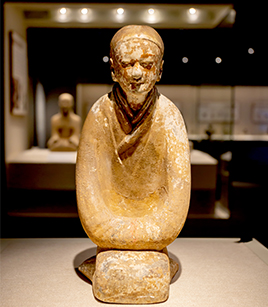Ba Mausoleum of Emperor Wen of Han

A kneeling pottery figurine unearthed from the Ba Mausoleum Photo: CFP
The Ba Mausoleum of Emperor Wen of Han (r. 180–157 BCE), the third emperor of the Western Han Dynasty (206 BCE–8 CE), is a large-scale mausoleum on the White Deer Plain in Xi’an, Shaanxi Province. The mausoleum was previously known as the Jiangcun Grand Tomb. It was identified as the tomb of Emperor Wen in 2021, based on archaeological findings.
The layout of the Ba Mausoleum is similar to the Chinese traditional character “亞” and the tomb chamber has a length of about 72 meters. The tomb was surrounded by over one hundreds outer burial pits. Over 1,000 dressed pottery figurines, more than 3,000 artifacts made of gold, silver, copper, iron, and clay, as well as many lacquer works were unearthed. The Ba Mausoleum is 800 meters away from the mausoleum of Empress Dou. A rammed earth wall encloses the mausoleums of Emperor Wen and Empress Dou in a large cemetery, aligning with the Han tradition that the imperial couple should be buried together.
In August 2023, archaeologists announced that they had unearthed the skeleton of a giant panda from the Ba Mausoleum. The skeleton, though dating back about 2,000 years, was in good condition. Its head was found oriented towards the imperial mausoleum, with its tail pointing west. The skull of a giant panda was found in the Mausoleum of Empress Dowager Bo in 1975, but its body was missing. Experts have claimed this to be the first discovery of a complete giant panda skeleton used as a burial accompaniment.
According to experts, extant giant pandas are divided into Sichuan and Qinling subspecies. The Qinling giant panda features a round head and short mouth, making it appear more cat-like. The Sichuan giant panda, the more bear-like of the two, has a bigger, oval-shaped head. The unearthed panda was determined to be the Qinling subspecies. Experts speculated that the local climate at that time might have been 1 to 2 degrees higher than at present, and the northern slope of the Qinling Mountains may have been quite hot and humid.
Edited by REN GUANHONG
